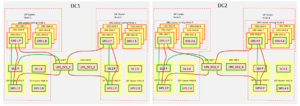Routing Optimization
Routing can be optimized for higher performance when there is a need for a system where multiple SIP Cluster nodes are required to handle high call volumes. Consider the following sample architecture diagram for a high performance solution:
In the above diagram, there is a central pair of URS instances in each data center. They are connected to extensive ORS clusters serving each SIP Cluster node. In effect, there are more ORS instances than SIP Server instances to process call volumes from each SIP Server instance.
The most efficient optimization is to run ORS on a dedicated virtual machine. You can also increase a number of ORS instances to run on each SIP Cluster node. Reduction of the number of agent reservation conflicts (as in a centralized routing solution) improves performance.
URS Scalability in a Centralized Routing Solution
If one URS pair is not capable of handling the load of the entire data center, you can increase the number of URS instances required per data center and distribute the SIP Cluster nodes to different URS pairs. In the following sample diagram, each URS pair serves two SIP Cluster nodes:
If the capacity of one URS HA pair allows to handle only, for example, two SIP Cluster nodes, new URS instances can be added to the solution as shown above.


